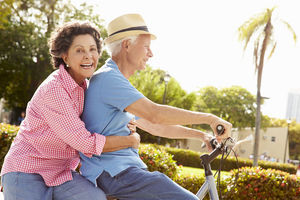In your middle years women usually get checked for bone density [LINK to diagnosis]. Follow your doctor’s instructions about how often to get checked because the guidelines are always changing. Be sure to ask for a copy of the results for your personal medical file. If you are in the normal bone density range, you probably don’t need to get checked again for several years, but talk to your doctor about that.
While people in this age range get osteoporosis more often than young adults, it is still relatively rare. Osteopenia is more common and the concern is that osteopenia will progress to full-blown osteoporosis.
Regardless of your bone density, there are things you can do to reduce your risk of developing osteoporosis. Some of these things are good for health in general (not just the skeletal system):
Dietary supplements – the value of calcium and Vitamin D supplements has been debated and continue to be debated. Talk to your doctor about this, but be aware that there is no consensus that supplements are beneficial. Experts agree that a healthy diet, which will include calcium and Vitamin D, is more important than supplements.
Exercise is probably the area where most middle-aged women could gain the most benefit as far as reducing osteoporosis risk. Exercise has a host of health benefits, of course, and these include reducing the risk of bone thinning.
Weight-bearing exercises include any activity which uses the muscles to hold up or lift the body’s weight. Walking, hiking, jogging, stair climbing, and dancing will help prevent osteoporosis or diminish its consequences. Lifting weights and carrying weights during morning walks also helps. Weights don’t just increase your muscle mass and tone. By pulling the large bones the muscles stimulate them, too, and make the  bones stronger. Participating 3 to 5 times per week in weight bearing exercise, for 30 to 60 minutes, both contributes to the fight against osteoporosis, and yields numerous other physical and emotional benefits. Brisk walking, jogging, and hiking are also great exercises. Tennis is also popular with middle-aged people and can provide good work on the muscles and large bones.
bones stronger. Participating 3 to 5 times per week in weight bearing exercise, for 30 to 60 minutes, both contributes to the fight against osteoporosis, and yields numerous other physical and emotional benefits. Brisk walking, jogging, and hiking are also great exercises. Tennis is also popular with middle-aged people and can provide good work on the muscles and large bones.
The International Osteoporosis Foundation estimates that worldwide 1 in 3 women and 1 in 5 men are at risk for an osteoporotic fracture. Steps you take in your middle years can help improve the quality of life in your older years.

